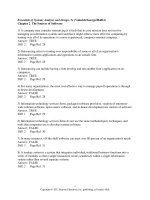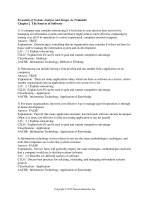Systems analysis and design methods 7th whitten and benley chapter 17
Bạn đang xem bản rút gọn của tài liệu. Xem và tải ngay bản đầy đủ của tài liệu tại đây (752.5 KB, 58 trang )
Systems Implementation
Introduction
The chapter will address the following questions:
What is the systems implementation process in terms of the
construction and delivery phases of the life cycle?
Can you describe the systems implementation phases in terms of
your information building blocks?
Can you describe the systems implementation phases in terms of
purpose, activities, roles, inputs and outputs, techniques, and
steps?
1
Systems Implementation
What is Systems Implementation?
What is Systems Implementation?
Systems implementation is the construction of the new system
and the delivery of that system into production (meaning day-today operation).
2
Systems Implementation
Operational System
Construction
Phase
Documentation
Delivery
Phase
Documentation
Repository
Approval to Continue Project
System
Owners/Users
3
Production
Information
System
Systems Implementation
The Construction Phase of Systems
Implementation
Introduction
The purpose of the construction phase is twofold:
To build and test a functional system that fulfills business and
design requirements, and
To implement the interfaces between the new system and
existing production systems.
The project team must construct the database, application
programs, user and system interfaces, and networks.
Some of these elements may already exist (subject to
enhancement).
4
Systems Implementation
INFORMATION SYSTEMS FRAMEWORK
FOCUS ON
SYSTEM
DATA
FOCUS ON
SYSTEM
PROCESSES
FOCUS ON
SYSTEM
INTERFACES
Database Scehma
Application Schema
FAST
Methodology
FOCUS ON
SYSTEM
GEOGRAPHY
SYSTEM
OWNERS
(scope)
S
Y
S
T
E
M
A
N
A
L
Y
S
T
S
SYSTEM
USERS
(requirements)
SYSTEM
DESIGNERS
(specification)
(components)
Initi at ion
Routine
Pr oces s
an Orde r
Shutdown
Rout ine
G et an
Order
Val idate
an Orde r
Fil e an
O rder
CREATE TABLE CUSTOMER
(customer_no CHAR(10) NOT NULL
customer_name CHAR(32) NOT NULL
customer _rating CHAR(1) NOT NULL
balance_due DECIMAL(5,2)
CREATE INDEX cust_no_idx on CUSTOMER
CREATE INDEX cust_rt_idx on CUSTOMER
Database
Technology
(and standards)
Network Schema
Cust omer
Fo rm
New Cus tomer
Logon
Ord er Acce pted
Change
of
Addre ss
New Order
Communications
Controller
St. Louis
Mainframe
NT Server LA
Order Help Complete
O rder Fo rm
Request Order He lp
ORDER_PRODUCT
ORDER
order_no [Alpha(12)] INDEX ORDER.order_no
order_date [Date(mmddyyyy) PRODUCT.product_no
quantity_ordered [Integer(2)
CUSTOMER.custom er_no
Database Structures
SYSTEM
BUILDERS
Interface Schema
O rder
Processing
Pr ogram
PRODUCT
CUSTOMER
product_no [Alpha(10)] INDEX
customer_no [Alpha (10)] INDEXproduct_name [Alpha(32)]
customer_name [Alpha(32)]
unit_of_measure [Alpha(2)]
customer_rating [Alpha(1)] INDEX
unit_price [Real(3,2)]
balance_due [Real(5,2)]
quantity_available [Integer(4 )]
Check
Cus tome r
Credit
Che ck
Product
Data
Cust ome rs
Product s
Check
Credit
Data
Rel ease
an
O rder
Help +
First Order
Request
Product
Lookup
PBX
NT Server NY
Et hernet LAN/NT
Ethernet LAN/NT
Request Product Lookup Help
Indy AIX Server
Product Lookup Help C omplet e
Or de rs
Application Programs
Pro duct
Lookup
Component Programs
VALIDATE_AN_ORDER.
REPEAT UNTIL NO_MORE_ORDERS
PERFORM CUSTOMER_VALIDATIO
REPEAT UNTIL NO_MORE_ORDER
PERFORM PRODUCT_VALIDATI
END REPEAT.
PERFORM CREDIT_CHECK.
IF CREDIT_CHECK 'BAD' THEN
On Event Help.ButtonClick Do
Change Focus HelpDialog
On Event OKButton Do
Begin
{proecdure}
End
On Event CancelButton Do
Interface
Technology
Software
(and Hardware)
Technology
Client PC
Client PC
Client PC
Client PC
Enternet LAN AIX/Lan
Manager
Network Programs
Create AccountType =
SalesClerk
Set OrderDir.Rights=full
Set CustomerDir.Rights=full
Set ProductDir.Rights=read
Set OrderAppDir.Rights=copy
Networking
Telchnology
(and standards)
(and standards)
(and standards)
5
Construction Phase
Systems Implementation
System
Owners
Approval
to
continue
project
Build
and Test
Networks
Installed
Network
The
Business
New
Databases
Quality
Assurance
Group
Network Network
Design
Details
Requirements
Revised Database
Schema and
Test Data Details
Program
Documentation
Quality
Recommendations
and
Requirements
Write
and
Test
New
Programs
DatabaseDesign
Requirements
Repository
Integration
Requirements
& Program
Documentation
Technical Design
Statement, Plan For
Programming, and
Test Data
Build and
Test
Databases
Modified S/W Specs
and New Integration
Requirements
Database
Structure
Sample Data
Install and
Test New
Software
Package
Software
Packages
and
Documentation
Production
Databases
System
Vendors
Software
Package
Program Documentation
New Programs & Reusable S/W Components
Reusable Software Components
6
Software
Library
Systems Implementation
The Construction Phase of Systems
Implementation
Activity: Build and Test Networks (if Necessary)
Purpose:
The purpose of this activity is to build and test new networks
and modify existing networks for use by the new system.
Roles:
This activity will normally be completed by the same system
specialists that designed the network(s).
• System Owners and system users - not involved in this activity.
• System analyst - The systems analyst’s role is more in terms of a
facilitator and ensures that business requirements are not
compromised by the network solution.
• Network designer - The network designer is a specialist in the
design of local and wide area networks and their connectivity.
7
Systems Implementation
The Construction Phase of Systems
Implementation
Activity: Build and Test Networks (if Necessary)
Roles: (continued)
• System builders.
– Network administrator - This person has the expertise for
building and testing network technology for the new system.
He/she will also be familiar with network architecture
standards that must be adhered to for any possible new
networking technology.
Prerequisites (Inputs):
This activity is triggered by the approval from the system
owners to continue the project into systems design.
The key input is the network design requirements defined
during systems design.
8
Systems Implementation
The Construction Phase of Systems
Implementation
Activity: Build and Test Networks (if Necessary)
Deliverables (Outputs):
The principle deliverable of this activity is an installed
network that is placed into operation.
Network details will be recorded in the project repository for
future reference.
Applicable Techniques:
Skills for developing networks are becoming an increasingly
important skill for systems analyst -- especially given the
industry trend toward downsizing existing applications.
9
Systems Implementation
The Construction Phase of Systems
Implementation
Activity: Build and Test Networks (if Necessary)
Steps:
The following steps are suggested to complete this activity.
• Step 1 - Review the network design requirements outlined in the
technical design statement developed during systems design.
• Step 2 - Make any appropriate modifications to existing networks
and/or develop new networks.
• Step 3 - Revise network specifications for future reference.
10
Systems Implementation
The Construction Phase of Systems
Implementation
Activity: Build and Test Databases
This task must immediately precede other programming activities
because databases are the resources shared by the computer programs to
be written.
Purpose:
The purpose of this activity is to build and test new databases and
modify existing databases for use by the new system.
Roles:
This activity will typically be completed by the same system
specialist that designed the databases.
• System owner and system users - are not involved in this activity.
• Systems analyst - (optional) When the database to be build is a noncorporate, applications-oriented database the systems analyst often
completes this activity.
11
Systems Implementation
The Construction Phase of Systems
Implementation
Activity: Build and Test Databases
Roles: (continued)
• System designers - The system designer will often times become the
system builder responsible for the completion of this activity.
• System builder - is primarily responsible for this activity.
• Database administer - When the database to be build is a corporate
database, the database administrator will be play a large role in
completing this activity.
Prerequisites (Inputs):
The primary input to this activity is the database design
requirements specified in the technical design statement during
systems design.
Sample data from production databases may be loaded into tables
for testing the databases.
12
Systems Implementation
The Construction Phase of Systems
Implementation
Activity: Build and Test Databases
Deliverables (Outputs):
The end-product of this activity is an unpopulated database
structure for new database.
• The term unpopulated means that the database structure is
implemented but that data has not been loaded into the database
structure.
Revised database schema and test data details are also
produced during this activity and placed in the project
repository for future reference.
13
Systems Implementation
The Construction Phase of Systems
Implementation
Activity: Build and Test Databases
Applicable Techniques:
Sampling. Sampling methods are used to obtain representative
data for testing database tables.
Data Modeling. This activity requires a good understanding of
data modeling.
Database Design. Understanding database design requirements
is essential for completing this phase.
Steps:
The following steps are suggested to complete this activity.
• Step 1 - Review the technical design statement for database design
requirements.
14
Systems Implementation
The Construction Phase of Systems
Implementation
Activity: Build and Test Databases
Steps: (continued)
• Step 2 - Locate production databases that may contain
representative data for testing database tables. Otherwise, generate
test data for database tables.
• Step 3 - Build/modify databases per design specifications.
• Step 4 - Load tables with sample data.
• Step 5 - Test database tables and relationships to adding,
modifying, deleting, and retrieving records. All possible
relationships paths and data integrity checks should be tested.
• Step 6 - Revise database schema and as necessary for future
reference.
15
Systems Implementation
The Construction Phase of Systems
Implementation
Activity: Install and Test New Software Package (if
Necessary)
Purpose:
The purpose of this activity is to install any new software
packages and make them available in the software library.
Roles:
This is the first activity in the life cycle that is specific to the
applications programmer.
• System owner and system users - are not involved in this activity.
• Systems analyst - (optional) The systems analyst typically
participates in the testing of the software package by clarifying
requirements.
16
Systems Implementation
The Construction Phase of Systems
Implementation
Activity: Install and Test New Software Package (if
Necessary)
Roles: (continued)
• System designers - The system designer may be involved in
clarification of integration requirements and program
documentation that is used in testing the software.
• System builder - is primarily responsible for this activity.
– Applications programmer - The applications programmer (or
programming team) is responsible for the installation and
testing of new software packages.
– Network Administrators - Network administrators may be
involved in actually installing the software package upon the
network server.
17
Systems Implementation
The Construction Phase of Systems
Implementation
Activity: Install and Test New Software Package (if
Necessary)
Prerequisites (Inputs):
The main input to this activity is the new software packages
and documentation that is received from the system vendors.
The applications programmer will complete the installation and
testing of the package according to integration requirements
and program documentation that was developed during
system design.
18
Systems Implementation
The Construction Phase of Systems
Implementation
Activity: Install and Test New Software Package (if
Necessary)
Deliverables (Outputs):
The principle deliverable of this activity is the installed and
tested software package(s) that are made available in the
software library.
Any modified software specifications and new integration
requirements that were necessary are documented and made
available in the project repository to provide a history and
serve as future reference.
19
Systems Implementation
The Construction Phase of Systems
Implementation
Activity: Install and Test New Software Package (if
Necessary)
Applicable Techniques:
There are no specific techniques applicable to this activity.
Successful completion of this activity is primarily dependent
upon programming experience and knowledge of testing.
Steps:
The following steps are suggested to complete this activity.
• Step 1 - Obtain the software packages and review documentation.
• Step 2 - Install the software package.
• Step 3 - Conduct tests upon the software packages to ensure that it
works properly - making revisions as necessary.
20
Systems Implementation
The Construction Phase of Systems
Implementation
Activity: Install and Test New Software Package (if
Necessary)
Steps: (continued)
• Step 4 - For future reference, revise software specifications to
reflect modifications.
• Step 5 - Add the software to the information systems shop's
software library.
21
Systems Implementation
The Construction Phase of Systems
Implementation
Activity: Write and Test New Programs
Purpose:
The purpose of this activity is to write and test all programs to be
developed in-house.
Roles:
This activity is specific to the applications programmer.
• System owner and system users - are not involved in this activity.
• Systems analyst - (optional) The systems analyst typically serves
merely in clarifying business requirements to be implemented by the
programs.
• System designers - The system designer may be involved in
clarification of the programming plan, integration requirements, and
program documentation (developed during systems design) that is used
in writing and testing the programs.
22
Systems Implementation
The Construction Phase of Systems
Implementation
Activity: Write and Test New Programs
Roles: (continued)
• System builder - is primarily responsible for this activity.
– Applications programmer or programming team - The
applications programmer is responsible for writing and testing
in-house software.
– Application tester - an application or software tester specializes
in building and running test scripts that are consistently applied
to programs to test all possible events and responses.
23
Systems Implementation
The Construction Phase of Systems
Implementation
Activity: Write and Test New Programs
Prerequisites (Inputs):
The primary input to this activity is the technical design
statement, plan for programming, and test data that was
developed in during systems design.
Since any new programs or program components may have
already been written and in use by other existing systems, the
experienced applications programmer will know to first check
for possible reusable software components available in the
software library.
24
Systems Implementation
The Construction Phase of Systems
Implementation
Activity: Write and Test New Programs
Prerequisites (Inputs): (continued)
Some information systems shops have a quality assurance group
staffed by specialists who review the final program
documentation for conformity to standards.
• This group will provide appropriate feedback regarding quality
recommendations and requirements (OPT).
Deliverables (Outputs):
The principle deliverable of this activity is the new programs
and reusable software components that are placed in the
software library.
This activity also results in program documentation that may
need to be approved by a quality assurance group.
25









